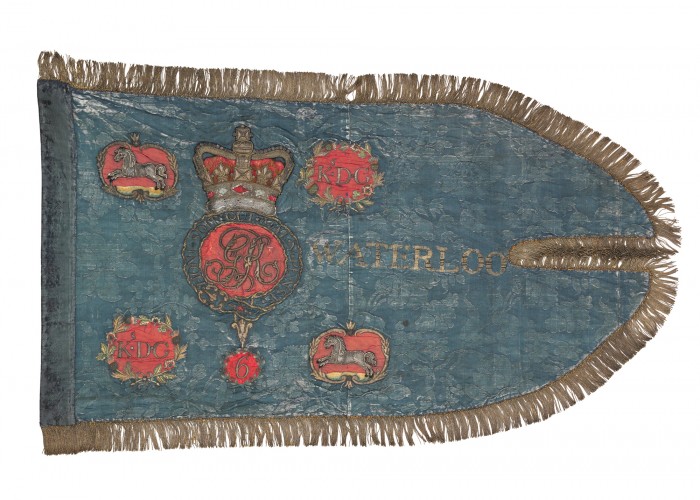King’s Dragoon Guards Standard
This is the guidon, or banner, carried at the Battle of Waterloo by a British cavalry regiment, the 1st (King’s) Dragoon Guards. This was the largest regiment of British mounted soldiers on the battlefield, with 583 men. The King’s Dragoon Guards were part of the Allied Union Brigade, which suffered terrible casualties when they were attacked by the French cavalry.
The King’s Dragoon Guards were a regiment of heavy cavalry, well-armed and intended to fight the enemy hand-to-hand. Cavalry regiments, rather than having a standard square colour flag, had the swallow-tailed guidon you can see above. The name comes from the French guide homme, guide man – the guidon-carrier was supposed to ride at the head of the regiment, guiding his fellow soldiers into battle.
At the Battle of Waterloo, the King’s Dragoon Guards were assembled with the other Anglo-Allied cavalry into the Union Brigade, which made a disastrous attack on the French infantry at about 2.30pm.The French I corps under Marshal D’Erlon assembled in four large columns, and marched up the hill towards the ridge of Mont St. Jean, where the Allied army was assembled. After the French were forced back from the ridge by Allied cannon and musket fire, the cavalry of the Union Brigade attacked them, and chased the retreating I Corps into the valley below Mont St. Jean. This charge captured 2000 prisoners and two French Eagle standards.
However, the soldiers of the Union Brigade charged too far, pursuing the infantry right up to the French cannons on the opposite ridge. A British Major, De Lancey Evans explained that he and “all the officers of any discretion” tried to order their troops to turn back, but were ignored by their blood-crazed men. Scattered and with their horses exhausted from galloping across the valley, the Union Brigade were caught by the French cavalry, who inflicted terrible casualties. At least 2,400 French soldiers on horseback, armed with lances and swords, cut the British regiments to pieces.
The King’s Dragoon Guards suffered 279 men were killed or wounded, including the commanding officer Lt. Colonel Fuller. This was 48% of all soldiers in the regiment at Waterloo, the highest casualty rate of any cavalry unit in the Anglo-Allied army. Despite the chaos, the bloodied survivors of the charge were able to retreat back to the Allied lines carrying this banner. It later had the battle honour “Waterloo” added.
-
Education overview
Learn the story of Sergeant John Adams, a soldier of the King’s Dragoon Guards, on the Waterloo 200 Schools E-Book. Manchester Creative & Media Academy have researched the life of this local Waterloo veteran and created their own virtual display of Waterloo artefacts.
If you’re a teacher, student, or parent, you can join the Waterloo 200 Schools programme. To find out how to sign up your class and discover your local Waterloo history, contact [email protected].
-
Curatorial info
- Originating Museum: Firing Line Cardiff Castle Museum of the Welsh Soldier
- Size: 27 in × 41 inches
-
Use this image
You can download and use the high resolution image for use in a non-profit environment such as a school or college, but please take note of the license type and rights holder information below
- Rights Holder: Copyright Firing Line Museum of the Welsh Soldier. Photography Relic Imaging Ltd.
- License Type: Creative Commons
Find it here
This object is in the collection of Firing Line: The Cardiff Castle Museum of the Welsh Soldier








